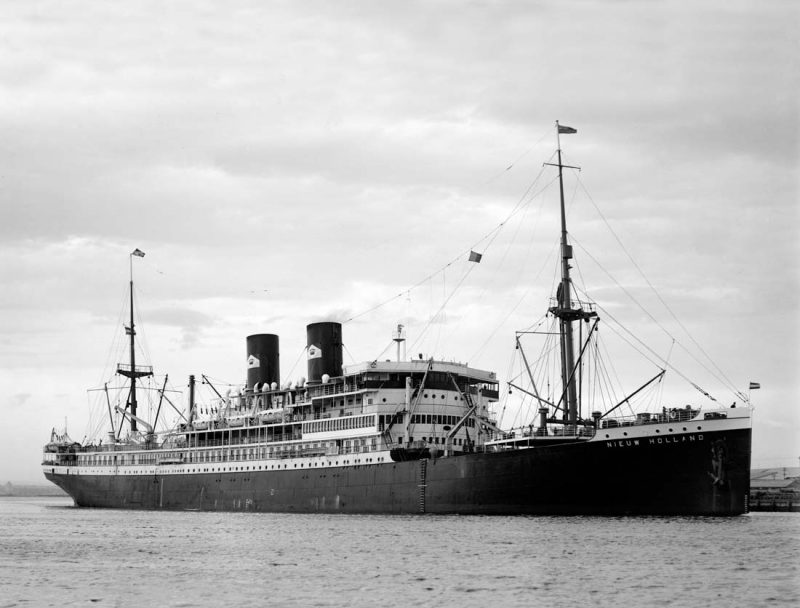
Dutch control of what is now Indonesia began in 1595 with the establishment of the Dutch East Indies Company (VOC), and two centuries later the islands previously dominated by the VOC were taken under the Dutch Government colonial umbrella. Java became the focus of Dutch control from a capital at Batavia (later Djakarta), and the five million Javan population of that time formed a relatively stable community in the Dutch colony. In 1888, the Koninklijke Paketvaart Maats (K.P.M.) or the Royal Paket Navigation Company was established to link all of the many islands and ports of the Dutch East Indies.
K.P.M. had a huge fleet of one hundred steamers, stern wheelers and small motor coasters in 1920, and had almost forty services from Singapore and Java to all of the Dutch East Indies as well as to South China, Burma, Thailand, Mauritius and to East and South Africa.
The majority of this huge fleet of passenger and cargo vessels were under 3,000 grt, but two larger flagships were ordered from well known shipyards in Amsterdam and Rotterdam for completion in 1928 as Nieuw Holland and Nieuw Zeeland for the important Java-Australia Line.
Another Dutch shipping company, the Java China Japan Line (J.C.J.L.) formed in 1903, worked in conjunction with the K.P.M. and after World War II years formed a merger group of these two big Dutch fleets.
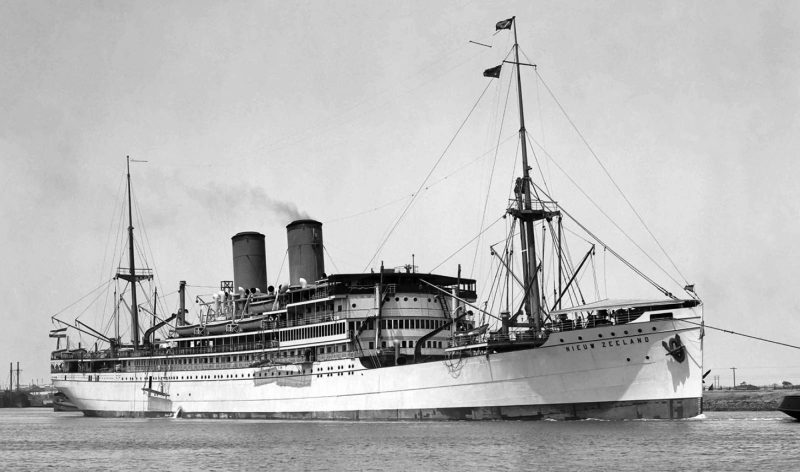
The Dutch East Indies
The Dutch successfully ruled the Dutch East Indies for 350 years, but as with the British Raj in India, the ruling countries committed some appalling atrocities. The sprawling Dutch East Indies archipelago was home to hundreds of disparate ethnic groups, with only two main tribes, one in the west on Sumatra and one in the east in the small groups of islands.
The Dutch with considerable effort managed to unite a small portion of this region under a single jurisdiction. Dutch colonialism played a key role in clearing the way for Indonesian independence by destroying or crippling the many indigenous tribes that would have formed a basis for several nations in their own right.
During the long slow conquest of the area, the Dutch confronted and defeated one tribe after another e.g. the Sea Warriors of Ternate and Tibore, the Banda tribe were completely exterminated after opposing the planting of nutmegs, the Muslims of Aceh on Sumatra were defeated after thirty years of bloody war that lasted until World War I, the Mataram tribe of Java had been massacred in the 1850s, and the Kalimantan (Borneo) forest tribes could not offer much opposition and were quickly overrun.
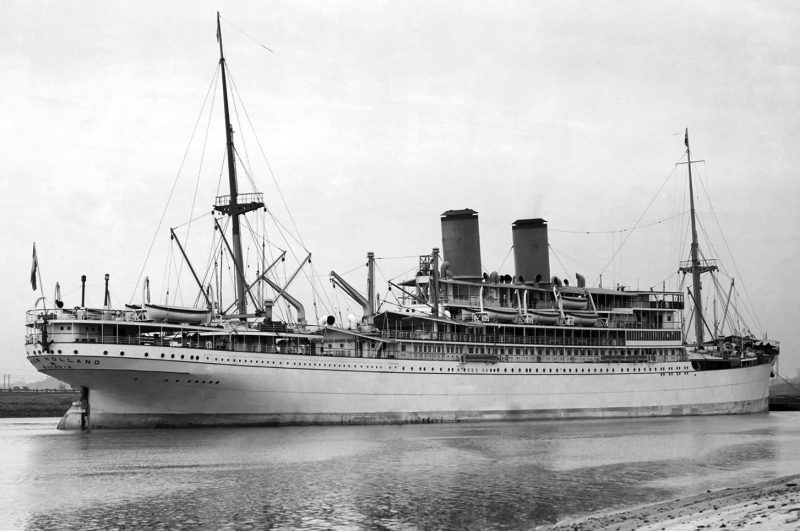
The Muslims of the Dutch East Indies naturally resented being ruled by a Christian country, and the celebration in 1915 in Batavia of the centenary of the liberation of Holland from Napoleonic rule deeply offended many in the archipelago, and stiffened resistance. The National Youth Congress of 1928 formally adopted a new Indonesian flag, language and anthem in preparation for their eventual independence. The turbulent politics of the 1930s and 1940s in the archipelago was at odds with what the Dutch thought of as ‘a golden era of colonial rule’.
The eventual first President of Indonesia, Sukarno, was imprisoned in the 1930s for leading a policy of non co-operation with Dutch rule, after armed rebellions had failed in 1926/27.
The means of how to achieve independence from the Dutch taxed the brains of many opposition leaders and the population of the archipelago for several decades until full independence was at last won in the last days of 1949.
Design And Specification Of The K.P.M. Flagships
The K.P.M. fleet grew in size to connect all of the islands of the archipelago, and thought was then given by the company to starting a new service to Australia around 1921. The passenger liners Houtman of 5,041 grt built in 1913 at the Nederland yard in Amsterdam and Tasman of 4,978 grt built in 1921 by the Earle’s yard at Hull were the two passenger liners on the Australia route when the two new flagships were laid down in 1927. Nieuw Holland was building at the Nederland yard in Amsterdam, while Nieuw Zeeland was building at the Rotterdam Dry Docks yard in Rotterdam. The twin funnelled pair with white hulls were identical sisters outwardly but differed in the design and decoration of their public rooms, and had dimensions of overall length of 559.5 feet, length between perpendiculars of 540.5 feet, with a moulded beam of 62.7 feet and a depth to the Upper Deck of 35.6 feet. They had two steel decks in their hulls, the Main and Upper Decks, above which was a very long Bridge Deck of length 245 feet, a fo’c’stle of length 44 feet, and a poop of length 26 feet. The central accommodation block had the Promenade and Boat Decks with accommodation for 123 First Class passengers, fifty in Third Class, and 785 deck or steerage passengers down in the ‘tween decks. Gross tonnage worked out at 10,903, with net tonnage at 6,600, and a deadweight of 10,200 tons at a loaded draft of 26.6 feet.
The keel of Nieuw Holland was laid at Amsterdam on 2nd April 1927, and she was launched on 17th December 1927 and completed on 20th April 1928. Nieuw Zeeland was laid down at Rotterdam and launched on 6th January 1928 and was placed on the important Java to Australia route on 12th April 1928. Their hulls were subdivided by eleven main bulkheads, giving a dozen sections of six holds, forepeak and aftpeak, boiler room and engine room, and two deep tanks for fuel oil.
The foremast and mainmast were very tall, and together with two sets of posts, held a good array of thirteen derricks of three tons capacity with a 25 ton heavy lift derrick fitted on the foremast, while four electric cranes of two tons capacity were fitted in the fore and aft open deck spaces. The steering gear was electro-hydraulic while the winches, windlass and capstan were all electrically operated. The Welin quadrant davits supported fifteen lifeboats and a motor boat. The six holds and ‘tween deck spaces had a bale cargo carrying capacity of 368,000 cubic feet together with 53,000 cubic feet of refrigerated cargo from the Dutch East Indies for the carriage of fruit, rice, maize, sugar cane, tea, coffee, rubber, vegetables, spices and nutmegs.
A service speed of fifteen knots was obtained from geared turbines of 8,000 shp to twin propellers, those of Nieuw Holland were constructed by Stork of the reaction type, while those of Nieuw Zeeland were constructed by the Fijenoord yard and were of the impulse type.
The four Babcock and Wilcox watertube boilers were fired either by oil fuel or coal and had closed furnaces, forced draught, with a safety valve load of 290 pounds, and a superheater temperature of 670 degrees Fahrenheit. These types of boilers were fitted to many Dutch built ships of this period of time, with bunker capacities being 1,900 tons of oil or 735 tons of coal. Unfortunately, the Fijenoord built turbines of Nieuw Zeeland proved unreliable and unsuccessful, and were replaced in 1935/36 at Vlissingen by new Stork built turbines.
All K.P.M. passenger liners were fitted with copious quantities of awnings arranged on awning spars, together with mahogany shutters clipped back to the bulkheads, in order to dissipate the heat from the very high range of temperatures experienced in the tropics.
The Promenade Deck had side windows at its fore end and abaft these were teakwood side screens to protect passengers from the frequent tropical downpours. Nieuw Holland and Nieuw Zeeland were no exception to K.P.M. liners in this respect, and extra fittings could be rigged if tropical rain was persistent. The Public Rooms on the Upper, Bridge, Promenade and Boat Decks were as follows:-
- UPPER DECK ‘midships had the First Class Dining Room decorated in ebony and white and seated 126 diners at tables from 2 to 10.
- BRIDGE DECK above Upper Deck consisted of the Main Entrance Hall forward with a long row of staterooms stretching aft.
- PROMENADE DECK above Bridge Deck was the main deck for public rooms of the Lounge, Music Room, Smoking Room, Verandah café and bar. Two years after their completion, the Promenade Decks were extended aft to the mainmast with further staterooms below on Bridge Deck to give an enlarged passenger capacity of 155 First Class passengers and a gross tonnage of 11,057. Third class passengers were located aft of the swimming pool.
- BOAT DECK above Promenade Deck had the accommodation for the navigating officers, as well as the gymnasium and an open sports area.
- Nieuw Holland and Nieuw Zeeland were the only twin funnelled liners in the huge K.P.M. fleet of Dutch East Indies traders, and allowed K.P.M. to extend their route to Singapore and Penang to give an itinerary of Penang, Singapore, Batavia (Java), Samarang (Java), Sourabaya (Java), Macassar (Celebes), to Brisbane, Sydney (NSW) and Melbourne. A monthly schedule on this route of almost five thousand miles was maintained by this fine pair of liners with names to suit the inhabitants of Australasia in Nieuw Holland (Australia) and Nieuw Zeeland (New Zealand).
The gorgeous yellow twin K.P.M. funnels fitted with black cowls on top, the graceful and traditional counter sterns flying the Dutch flag from the poop, and the slightly raked masts made this pair of liners the most elegant and handsome K.P.M. flagships.
The appearance of this pair of liners could be greatly changed aft by the varied addition of large shutters to give an almost continuous Bridge Deck and Poop Deck.
World War II And Indonesian Independence
Nieuw Holland and Nieuw Zeeland had given twelve years of excellent service by April 1940, when Holland was overrun by German forces, and the K.P.M. flagships were transferred to the management of the British Government for use as troopers whilst retaining their Dutch crews and flag.
They trooped in many theatres of the first half of World War II, and Nieuw Zeeland carried a full complement of troops for Operation Torch, the Allied landings in North Africa in October and early November 1942.
She was then unfortunately torpedoed by U407 on the return voyage to the U.K. to the east of Algiers in position 39º57’ North, 3º58’ West. She drifted northwards a few miles and sank with the loss of 15 lives, these coming from the crew of 214, 29 gunners and 13 service personnel.
Nieuw Holland took part in the Normandy landings on D-Day of 6th June 1944, and between July and October of that year ferried over 27,000 men across the English Channel.
At the end of war and after a lengthy refit, she went back to her old route with her home port of Amsterdam instead of Batavia in Java, which secured independence from Holland on 27th December 1949 as the Republic of Indonesia.
The conditions of the Dutch East Indies changed greatly under new Indonesian rule, and thus Nieuw Holland had her route extended to include Adelaide and Fremantle to increase the number of Australian passengers travelling to Singapore.
It was the Japanese invasion in 1942 of the Dutch East Indies that swept away the Dutch colonial order in a huge show of armed force.
The strong anti-Western opposition of the Japanese convinced the population of the archipelago that eventually they would succeed in becoming independent, and they thus co-operated with the Japanese.
An Indonesian Republic was proclaimed in August 1945 after the Japanese surrender, led by its first President Sukarno (1901-1970), a Hindu born in Sourabaya on Java, and who held the post until 1967.
When the Dutch returned to the archipelago to take back power, this led to a three year war of Indonesian independence until 1948. The Dutch military campaign became bogged down, and after a last failed offensive in December 1948, the United States of America persuaded the Dutch to grant independence during the last days of 1949 as a bulwark against communism.
A new Indonesian Republic controlled Sumatra in the west, Java and Borneo in the centre, plus Sulawesi (Celebes), Bali, Lombok, the Sunda islands, the Maluku islands, and half of Timor and New Guinea in the east. President Suharto (1921-2008), a Javanese Muslim, took over in 1967 from President Sukarno and ruled for 31 years until he resigned on 21st May 1998.
Royal Interocean Lines
At the end of 1947 with the war for Indonesian independence escalating, the Java China Japan Line (J.C.J.L.) and the deep sea services of K.P.M. merged to form the Koninklijke Java China Packetvaart (K.J.C.P.), but used the trade name of Royal Interocean Lines for its agents, shippers and passenger services. Nieuw Holland was transferred to this new company along with several J.C.J.L. passenger liners with ‘Tji’ prefixes to their names and adopted the latter’s colours of black hull and twin black funnels. The latter also included the central houseflag of the new company with a rectangle with a white diamond in the centre and containing a gold crown and alternate red and blue corners. Thus, Nieuw Holland was no longer the white hulled K.P.M. flagship with twin yellow funnels, and had become one of many liners with twin black funnels and black hull of that period.

Nieuw Holland gave twelve more years of excellent service on her original route to Australia between 1947 and 1959, but at the age of 31 years she could no longer compete with the newer liners of Royal Interocean Lines. She was sold in February 1959 to shipbreakers in Hong Kong, and this much loved liner was sadly missed as she had meant a great deal to her Dutch, Indonesian and Australian passengers. Indeed, for many of them her voyages had been as much a pleasure cruise as a line voyage, and her peace time and wartime record had been exemplary. A new generation of liners would take over her route, two of which had the lovely white hulls with which Nieuw Holland had originally been put into service, and became known as the ‘Elegant White Yachts’ of the Australian run.
TJIWANGI and TJILUWAH
Nieuw Holland during her post-war years was relieved during her annual refits and longer special surveys on her Australian service by other liners of the Royal Interocean Lines e.g. Tjisadane of 9,284 grt completed in 1931 by the Nederland yard in Amsterdam with accommodation for 160 passengers in three classes plus 1,600 deck passengers in the ‘tween decks. Tjisadane made a round voyage in May and June of 1953 from Singapore to Sydney (NSW), Melbourne, Adelaide and Fremantle and return to Singapore. She had a sister named Tjinegara, which had been torpedoed and sunk by the Japanese submarine I 169 on 25th July 1942 when 700 miles east of Rockhampton in Australia while on a voyage from Rockhampton to Noumea with 477 horses and mules and several thousand crates of beer. This pair had a long Bridge Deck of length 133 feet, a fo’c’stle of length 53 feet, and a poop of length 109 feet.
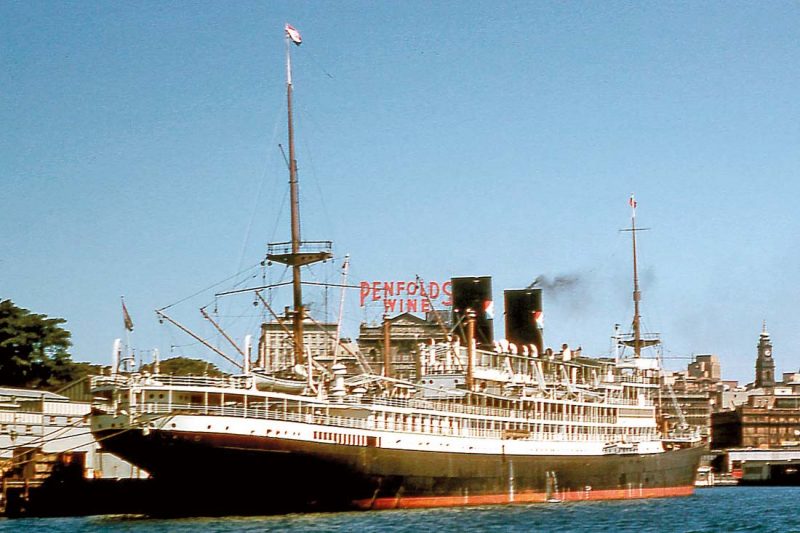
The largest dozen liners of the K.P.M. had transferred to the Royal Interocean Lines in 1947/48, leaving the smaller liners to sail on in Indonesia until K.P.M. had completely lost its ‘raison d’etre’ in the new non-colonial Indonesia. The State owned P.T. Pelarayan Nasional Indonesia (Pelni) shipping fleet was established on 28th August 1952, and gradually built up a modern fleet of passenger liners to connect all of the islands of the archipelago. In 1957, the Indonesian Government proclaimed a strike of all Indonesian workers of the K.P.M. and demanded a surrender of the K.P.M. fleet to Indonesia, this was rejected and thus the K.P.M. was forced in 1958 to leave Indonesia and the Head Office moved from Djakarta to Singapore.
Tjisadane carried on with her original route to China and Japan from Indonesia in 1946 until transferred a year later to the fast express service from the Far East including Japan and Korea to South Africa and South America, along with the larger former K.P.M. trio of 1938 liners named Boissevain, Ruys and Tegelberg of 14,285 grt, as well as Tjitjalengka of 10,972 grt built in 1939 and Tjinegara (2) of 9,067 grt built in 1951. It was during this South American period of service that Tjisadane is best remembered for her evacuation of all of the islanders of Tristan da Cunha during a devastating and violent volcanic earthquake and lava flow eruption.
Tremors had been felt during 4th August of 1961 followed by a violent volcanic eruption on 8th October with many lava flows threatening the small population, who had quickly moved from their homes to the fields and beaches. Tjisadane had by chance been requested by the British Government to collect six islanders for transport to Cape Town at this time, and was in the vicinity of the island at 0800 hours on 11th October. She was then tasked with the evacuation of all 291 islanders during a three hour period around midday of 11th October. The personal possessions of the islanders could not be rescued due to the high swell of the sea during the rescue by longboat. A Royal Navy frigate two days later managed to rescue these belongings as well as the church organ that had been presented by H. M. The Queen. Tjisadane delivered her islanders to Cape Town, where they disembarked and travelled to Southampton on the Union-Castle Line liner Stirling Castle built in 1936. A one shilling postage stamp was later issued for Tristan da Cunha to celebrate the safe rescue of all of the islanders by Tjisadane.
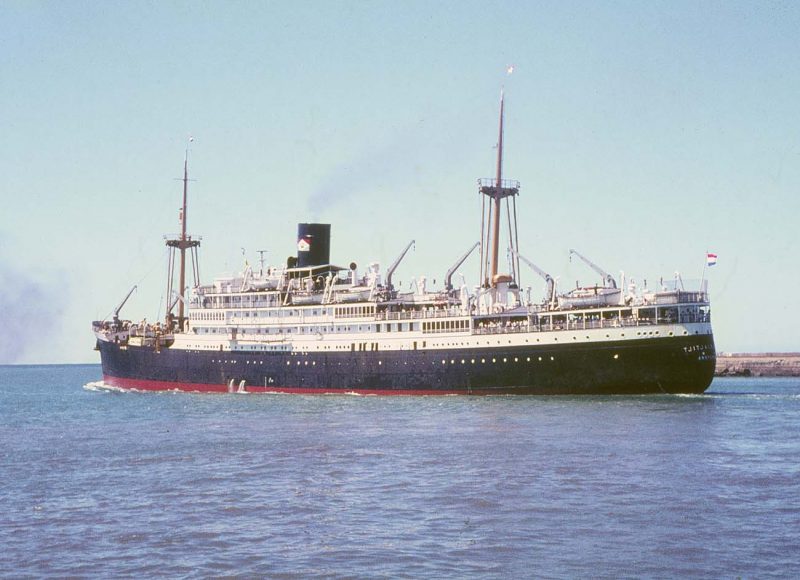
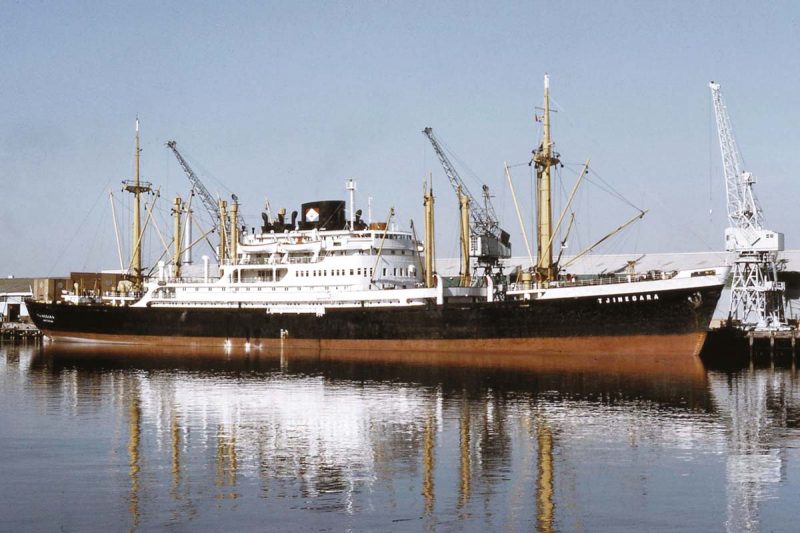
Royal Interocean Lines (or K.J.C.P.) had ordered two new liners in 1948 for the service from Djakarta (formerly Batavia) to Hong Kong from the Van der Giessen yard at Krimpen in Holland for completion during 1950/51. Tjiwangi was launched on 29th April 1950 and completed later in that year, while Tjiluwah was launched on 28th April 1951 and completed a few months later, both with black hulls and black funnels carrying the K.J.C.P. houseflag. Tjiwangi was transferred in July 1960 to the Australian service and was followed by her exact sister Tjiluwah one month later.
The dimensions of this pair of liners were length of 479.4 feet, moulded beam of 63.0 feet, depth of 36.7 feet and a draft of 23.7 feet, with a gross tonnage of 8,679 tons, net tonnage of 5,140 tons, and a deadweight carrying capacity of 6,166 tons. The Bridge Deck was long at 275 feet in length, and the decks in the hull included a shelter deck and a third deck forward and aft of the machinery spaces.
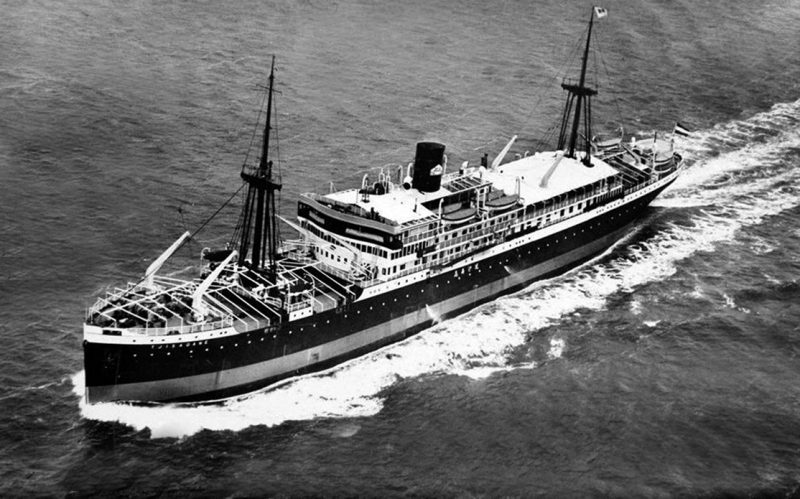
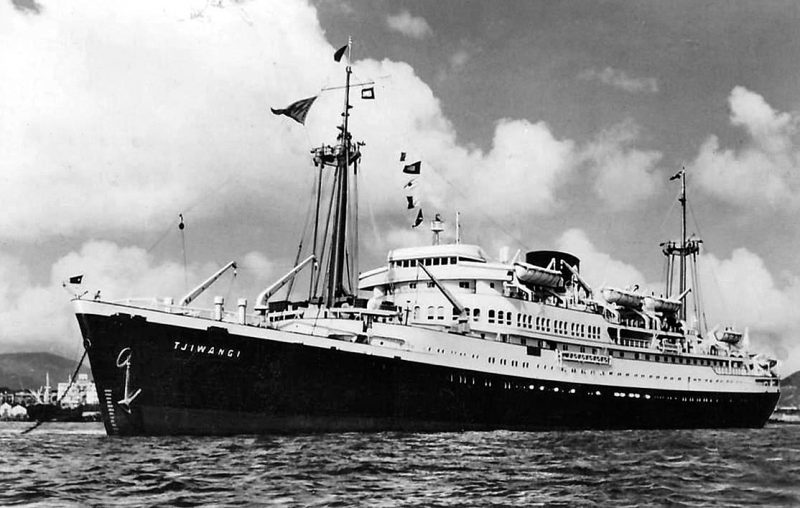
The collision bulkhead reached up to the shelter deck, and they had five holds and four hatches served by eight derricks of five tons capacity, plus a heavy lift derrick of twenty tons capacity on the foremast, and six electric cranes of three tons capacity for loading and unloading of cargo. The hull was rivetted and welded, and the hold capacity was 264,275 cubic feet (bale) and 267,422 cubic feet (grain). They carried ten lifeboats arranged around the Boat Deck, the mainmast, and the Poop Deck for the passenger complement of 98 First Class and 160 in Tourist Class. Twin eight cylinder Werkspoor diesel engines of 6,700 bhp built at Amsterdam drove twin propellers to give a service speed of sixteen to seventeen knots.
The engine room equipment included four 260 kW generators, and two auxiliary boilers for heating of cabins and public rooms. Oil fuel bunkers were 917 tons in tanks around the engine room and tunnel spaces, and 2,414 tons of water ballast was carried when light.
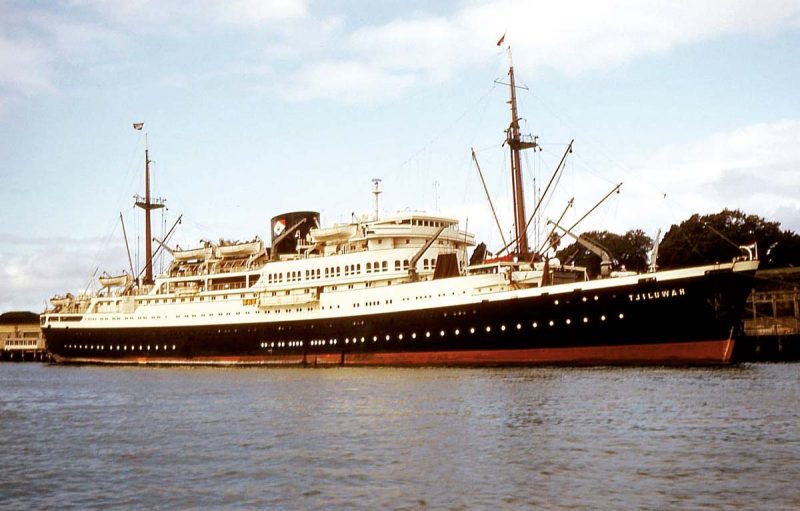
A crew of two hundred including a good number of stewards who were on hand to serve cool drinks while transitting the Tropics. The First Class staterooms and public rooms were fully air conditioned as built, but this was extended to the Tourist Class facilities in their 1963 refits. The five passenger decks in descending order were as follows:-
Promenade ‘A’ Deck
The First Class Lounge was forward and was very opulent with full length art and mirror decoration, tall standing lights with fabric lampshades, discrete ceiling lighting, and a large number of comfortable sofas and easy chairs. The decoration of the two sisters in terms of colour and fittings varied to a considerable degree. On either side to port and starboard of this Lounge was the Wintergarden, which was luxuriously appointed and much used for morning coffee. Cane furniture of good quality, fabric covered lampshades, curtains to the outside windows and potted plants gave a very desirable effect, which was much appreciated and remembered by First Class passengers. Aft of the Lounge was the Entrance Hall with an intimate and much used bar on the port side aft of the Entrance Hall, and on the starboard side was the Library and Card and Games Room. The Library had alcoves for better privacy for reading, with the light wooden shelving faced with glass doors, as well as business style seats. A swimming pool was installed aft and was surrounded by plenty of deck space and deckchairs.
Bridge ‘B’ Deck
The First Class staterooms comprised two single occupancy cabins, seventeen twin bedded cabins all with private facilities, and twenty further twin bedded cabins with a sofa for a third occupancy if required but with shared facilities. A further double bedded two berth cabin also shared facilities with the twin bedded rooms, but all cabins were fully air conditioned with décor of yellow and green. All staterooms were outside cabins with a stylish table placed between the twin beds with a large mirror above for passengers to dress and look their best for dinner, and thick curtains to be drawn to the portholes at night.
Tourist ‘C’ Deck
The Tourist Class cabins comprised forty rooms with four sharing a cabin, but had fan forced air cooling instead of full air conditioning until the latter was installed in 1963. Cabins had either one or two portholes, and were well fitted out with washbasin and mirror above, fold down desk for studying and reading, and heaters for use in the cool temperatures while transitting the Southern Bight of Australia between Adelaide and Fremantle. The Tourist Class Main Lounge and bar was good for meeting and socialising but small in dimensions.
Upper Deck
This deck had a fine viewing area and wraparound balustrades of the two deck, opulent First Class Dining Room located below on Main Deck. This was fully air conditioned with quite extravagant staircases leading to tables set for two, four or six diners. Again, the style of the room differed markedly between the two sisters, one being more stylish and modern, while the other had wooden carved handrails to the staircases, but both offered a dining experience to be remembered.
Main Deck
The beautiful staircases of the First Class Dining Room that ran from the Main Deck upwards to the Upper Deck above were positioned differently in the two sisters, one being forward of the two deck high First Class Dining Room and in the other sister being aft of the First Class Dining Room. Galleys and serving areas were aft of the Dining Room, and a very large number of stewards were on hand to expertly serve the wide ranging menus.
After three years on the Australian service with black hulls, Tjiwangi and Tjiluwah underwent a refit in 1963 to white hulls, and at the same time the Tourist Class Lounge was moved to a larger and more casual Verandah Lounge and Café on the starboard side aft of Promenade Deck. This rebuilding during 1963 to 104 passengers in First Class and 118 in Tourist Class combined with their white hulls made the pair become very well known throughout Australia as the ‘Elegant White Yachts’ on the route from Indonesia. The competition on this route was from Dominion Navigation Co. Ltd. managed by H.C. Sleigh Ltd. of Melbourne with the liners George Anson and Francis Drake of 7,700 grt built on the Tyne in 1947 by Vickers Armstrong Ltd. for Furness, Withy and Co. Ltd. as Newfoundland and Nova Scotia with accommodation for 130 passengers. The route from Japan and Hong Kong to Australia also had the P. & O. Group liner Aramac of 13,800 grt built by Harland and Wolff Ltd. in 1948 as Parthia for Cunard Line sailing via Sandakan and Manila with accommodation for 350 passengers.
However, Tjiwangi and Tjiluwah had a loyal and faithful clientele as they were much more favoured by their many passengers for their refined atmosphere, but the competition from two shipping lines and that from air travel finally spelled the end for one of the pair, Tjiluwah, in January 1972 when she was sold to Pacific International Lines (PIL) of Singapore and renamed Kota Singapura for a passenger service northwards from Singapore to China. Kota Singapura and her sister when she also joined the PIL fleet were adapted to carry sheep in pens in the holds.
Nieuw Holland (2)
A replacement for Tjiluwah was found from the Holland to South Africa service of the United Netherlands Navigation Company or the Vereenigde Nederlandsche Schepps (VNS) in the liner Randfontein of 13,694 grt and completed in early 1959 by the Wilton Fijenoord yard in Rotterdam. She was renamed Nieuw Holland (2) to perpetuate the name of the twin funnelled K.P.M. liner that was broken up in 1959. Randfontein was purchased in July 1971 but was sent to Hong Kong for an extensive six month refit that gave her a white hull and other improvements to make her a one class ship, together with an electric crane forward after the removal of a pair of derricks. She had a well deck forward, with eight lifeboats positioned ‘midships or aft. She was not given a navigation mast above the bridge when completed, instead the radar scanner was mounted on the crosstree of the foremast for a better reception of echoes. The later ownership under Cosco saw the liner receive a new funnel with the radar scanner then mounted on its forward end. Randfontein had become the last VNS liner on the South African route in 1967, and served out the route until her sale to Royal Interocean Lines in 1971.
Randfontein had dimensions of length 584.6 feet, moulded beam of 70.2 feet, depth of 39.0 feet, and a loaded draft of 29.6 feet. The combined Bridge Deck and Poop Deck was long at 417 feet in length, with a fo’c’stle of length 66 feet, and had three steel decks in her hull, which was riveted and welded. She had accommodation for 123 First Class passengers and 166 in Tourist Class, with First Class staterooms on Promenade ‘A’ Deck and Tourist Class on Bridge ‘B’ Deck. First Class passengers all had outside cabins with hinged windows instead of portholes to give a good view to seaward. First Class had private facilities, for all double, twin bedded and single occupancy cabins, some with upper Pullman berths for occupancy of three people if required. Tourist Class had cabins for two, four or six people with shared facilities, and each class had separate tiled swimming pools and air conditioned Dining Rooms. The First Class public rooms and staterooms on Promenade Deck were also fully air-conditioned.
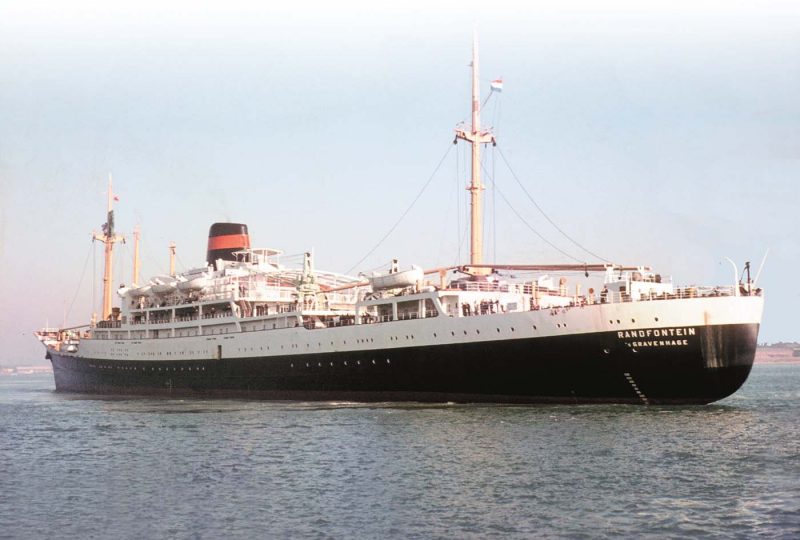
Randfontein had four holds and eight hatches, with a grain cargo capacity of 518,000 cubic feet served by sixteen derricks of between three and nine tons capacity, plus two electric cranes, with a fifty ton heavy lift derrick on the foremast. She had a deadweight of 11,765 tons, and also had spaces for refrigerated fruit cargoes and deep tanks had been installed to carry edible oils. She had been named as Randfontein on 24th November 1958 by Mrs. Geldenhuys, wife of the Ambassador to the Republic of South Africa in The Hague, and floated out of her building dock on the same day.
She made her maiden voyage on 6th January 1959 from Amsterdam and Southampton to Las Palmas, Cape Town, Port Elizabeth, East London and Durban. She replaced Klipfontein lost on rocks off Mozambique on 8th January 1953 while racing Bloemfontein Castle to the only passenger berth in Durban. She had a service speed of 18.5 knots from twin nine cylinder diesel engines of 15,400 bhp constructed by the shipbuilder and driving twin propellers. She had four generators of 440 kW capacity for electrical lighting and power.
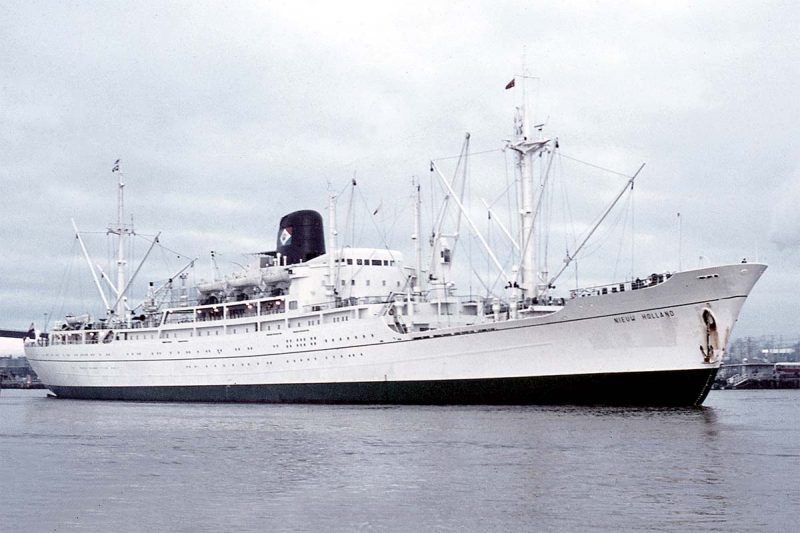
Nieuw Holland (2) made her maiden voyage for Royal Interocean Lines on 21st January 1972 from Hong Kong to Sydney (NSW) and Melbourne. A presentation was made to her Master at the start of the maiden voyage by the owners of a large decorated porcelain charger bowl made in Hong Kong and encased in metal. Nieuw Holland (2) made one cruise to New Zealand waters in 1973, but one year later, her running mate of Tjiwangi was handed over in January 1974 after sale to Pacific International Lines (PIL) to join her sister in that fleet as Kota Bali. The route of Nieuw Holland (2) was then varied at this same time to one of sailing from Adelaide to Risdon (Tasmania), Sydney (NSW), Brisbane, Port Moresby, Bali, Sourabaya, Djakarta, Singapore, Penang, Belawan (Sumatra) and return via Singapore to Adelaide. However, this enterprising trial route was also not successful and she made only four return voyages. Nieuw Holland (2) made her final sailing from Sydney (NSW) without fanfare on 22nd February 1974 to Singapore, after which she was sent to Hong Kong for several months of lay up. The change to containerised cargoes and the ascendancy of air travel had ended the Australian service from Indonesia and Singapore.
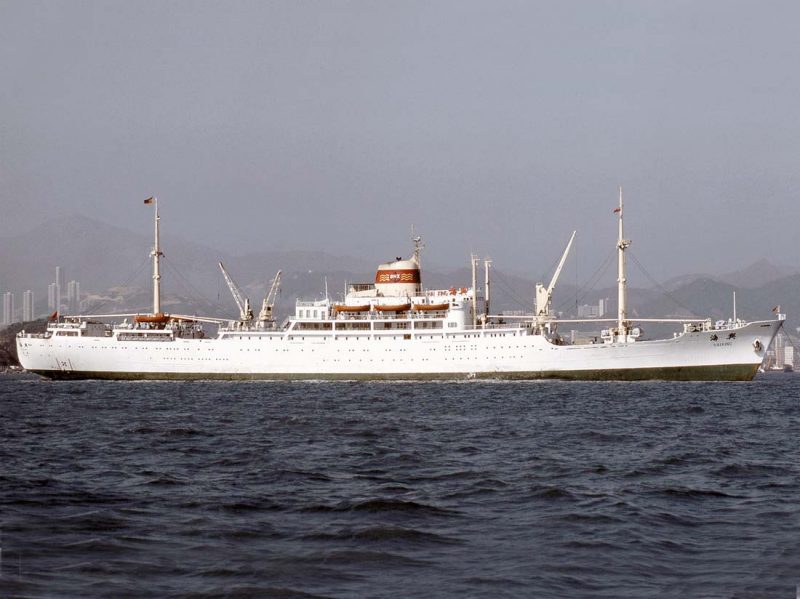
Nieuw Holland (2) was sold to Cosco of China and given a yellow funnel with a central red band carrying ‘SHX’ between two sets of triple wavy lines. She was renamed Yu Hua and carried Chinese workers from Shanghai and other Chinese ports to East Africa to work on several joint Chinese and East African building and transport projects. She was renamed Hai Xing in 1981 for Chinese coastal passenger services of the Shanghai Hai Xing Shipping Company, and made her final voyage to shipbreakers at Alang in India under the name of Herbert in 1996, after a good career of 37 years.
Postscript
The K.P.M. and the later Royal Interocean Lines had successfully run a passenger and cargo service from Java or Singapore to Australia for just over fifty years. Nieuw Holland had a successful career of 31 years, Tjiwangi had a similar long career of 33 years and her sister Tjiluwah a long career of thirty years. Randfontein, later Nieuw Holland (2) and a career under the Chinese flag lasted a full 37 years. These were very good looking, traditional passenger and cargo-liners, and looked very beautiful indeed when compared to the cruise ships and boxy container ships of today.

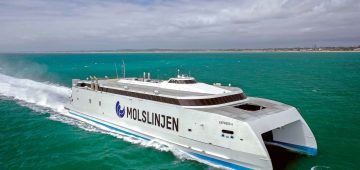



Comments
Sorry, comments are closed for this item